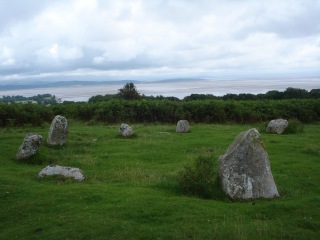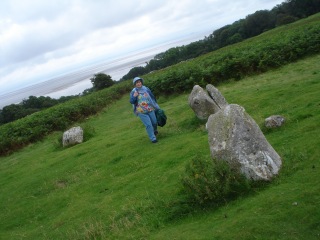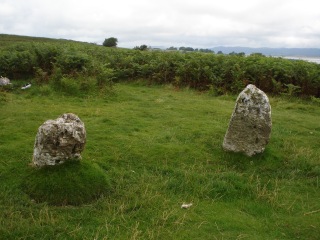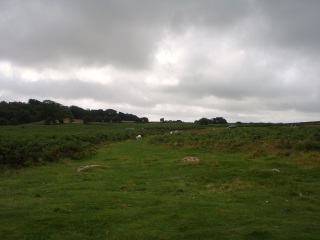 |
| The inner ring at The Druid’s Circle, at Birkrigg Common, near Ulverston, in Cumbria. |
We have been away, hence the somewhat patchy posts and lack of response to comments last week – you might as well be in outer space as far as Internet connections go in parts of Cumbria. Anyway, we are back home now and, hopefully, normal service has been resumed, and I have some holiday pictures which I’m planning to show you as Saturday Snapshots, including these, which were taken at the Druid’s Circle, at Birkrigg Common, which is near Ulverston, where Stan Laurel (of Laurel and Hardy) was born.
 |
| Me, walking around the inside. |
We usually stay up there once a year, because the Man Of The House comes from Barrow in Furness, and still has friends and relatives in the area. Barrow is a ship-building town, and is not at all beautiful, but it’s right at the top of Morecambe Bay, and the beaches are gloriously unspoilt, and it’s very close to the Lake District (it only takes 20 or 30 minutes to drive to Windermere). The countryside is just incredible – you have to see it to believe it – and the nearby towns and villages are lovely.
 |
| A closer view of two of the stones. |
This year we did lots of walking, and went to some places I’d never seen before, including this stone circle, which was almost hidden by the bracken and is, so we were told, much more visible during the winter, when the ferns die back. The grass inside the circle is kept short, but around it is a sea of very dense, very tall bracken, with wide grassy walkways through it. It was very lonesome, very wild, and very windy, and these prehistoric remains look like some kind of strange fairy circle, with stones sprouting up around the rim where there would normally be mushrooms – and it’s on a slightly grander scale!
 |
| You can just see three of the stones in the outer ring,very low down in the grass – almost at ground level. |
It’s a double circle, with 12 very weathered small stones forming an inner ring. The stones in the outer ring are difficult to count, because they are somewhat scattered, and even more weathered, and even smaller than the others. The circle is only about 27ft in diameter across the greatest part of the outer ring, and is believed to date from the Bronze Age, possibly from around 2,000 years BC. Apparently fragments of human bones were found in an urn during an excavation carried out in the early 20th century, and evidence of ancient fires was also uncovered. However the site remains as mysterious as other stone circles, and its significance is unknown. I have tried to do some research, but there doesn’t seem to be much information available, and I can’t discover whether it aligns in any way with the sun, moon, planets or stars. Some of the stones do line up with the spire of Bardsea Church and Chapel Island, and I think there is at least one old trackway nearby, but I don’t know if Druid’s Circle lines up with any other features in the landscape, or whether there are ley lines or anything like that.
 |
| This is another of the outer circle stones, right up against the bracken, which stretches far as the eye can see. |
It does feel very mysterious, and I imagine sunrise and sunset would be quite spectacular up here, but it would be a bit spooky in the dark, as its very isolated, with no lighting. The view down the hill to Bardsea village, Seawood, Bardsea Beach and out across Morecambe Bay was amazing, and I walked around the inner and outer rings, and stood in the centre, and tried to examine the stones, but it wasn’t as peaceful as we expected, because a group of Scouts on an activity day were cooking soup on a little camp stove to one side of the circle. They were were very well behaved, and were no trouble, but they obviously thought I was nuts wandering round touching the stones!
 |
| This was the view looking back over a gate as we walked up to the stone circle. You can see Bardsea Church spire, and Chapel Island, one of many tiny islands in Morecambe Bay. |
Oh Christine — terrific pictures.
You remind me of a great book I read once, by M. Scott Peck. It was called In Search of Stones, and it's a travelog of his journeys in Wales — visiting the menhirs and dolmens and standing stones that are there, everywhere.
LikeLike
Sounds an interesting book – I will try and find it. I'm fascinated by standing stones and stone circles.
LikeLike
What an interesting virtual tour you have given me this morning. Thanks for sharing your vacation photos and a bit of the history too!
LikeLike
Such a gorgeous spot, with a beautiful view, fascinating commentary too.
LikeLike
Wonderful pictures!
LikeLike
Thanks for the tour and the stories accompanying the shots. I would love to see this in person, too, but in the meantime…I'm glad to see the photos.
Here's MY SATURDAY SNAPSHOT POST
LikeLike
There's something so romantic about standing stones, maybe because I always think of that book The Outlander and how she went back in time through the standing stones. Maybe I have boring photos of Doritos because I don't take enough “holidays.” Here's Mine
LikeLike
Thank you Barbara. I'd love to know more about it, but stone circles always seem to be a mystery, and I guess wth no written records they will remain that way.
LikeLike
I had no idea what to expect, and I was completely knocked out by it when we got there.
LikeLike
That's kind of you to say. I'd like to go back next year, but earlier, before the bracken grows so much, and it might be easier to get clearer shots.
LikeLike
It's well worth seeing Larel-Rain, even though it's not as imposing as Stonehenge, but it is very atmospheric.
LikeLike
Paulita, your picture wasn't boring – it made me think about the way we look things, especially food, and I've been around the house trying to take photos of things like soup, and jars of pencils! By the way, I'm glad I'm not the only one who finds standing stones romantic, although I've yet to read Outlander.
LikeLike
I find the druid lore fascinating… probably because we know so little about them, other than they existed. That does seem like a vast area to walk, but such a pretty landscape it would be worth the hike.
LikeLike
Wow that is an amazing little spot there! Thanks for sharing your thoughts nd enlightening us.
Here is my Saturday Snapshot.
LikeLike
It was worth the hike Leslie. I'm not at all sure that the Druids had anything to with this site, despite the name, but they are interesting.
LikeLike
Marie, thank you for visiting and commenting.
LikeLike
Such a beautiful place to photograph!!
Here is my Saturday Snapshot post!
LikeLike
Thank you. It's nice to know there are still unspoiled wild areas left for us to enjoy.
LikeLike
beautiful country side, I have never gotten to see any stone circles, but i hope to one day 🙂 Thanks for sharing, Book Savvy Babe
LikeLike
If you ever get the chance, do visit. Even small ones like this are quite awesome.
LikeLike
I would love to explore some of those old stone rings. Every time I see mentions of them it makes me think of the Outlander series. 🙂
LikeLike
Alyce, you and Paulita have both mentioned Outlander, and a friend of mine raves about the series… I must read them!
LikeLike
Enjoy seeing what other's vacations are like….thanks for sharing♫
LikeLike
Thank you! I had a lovely day!
LikeLike
It's interesting to learn about the history of those stones that formed a circle for a purpose 2000 years ago or more..
It's a lovely countryside.
LikeLike
Edgar, the countryside all over the Furness Peninsula is spectacular, and very varied.
LikeLike
I wanted to know where the stones were located and found this site
http://www.megalithics.com/wales/druids/drudmain.htm
It seems the site was excavated and remains of infants were found there. Sinister?
Good pictures anyway and some neat landscape shots.
LikeLike
The Druid's circle and the surrounding scenery is stunning!!!
LikeLike
Thank you Staci, it was an amzing place.
LikeLike
I think the Druid's Circle you mention is actually a different one. The one we visited ins in Cumbria, and the one you link to is in Gwynedd, which is in Wales – but they do look very similar. It gets very confusing, because quite a few stone circles are known as Druid's Circles, or Druid's Stones. Sorry!
LikeLike
The Druid's circle looks amazing! I love the picture from the view from the gate as well, beautiful!
LikeLike
Meaghan, that's really kind of you to say so. Thank you.
LikeLike